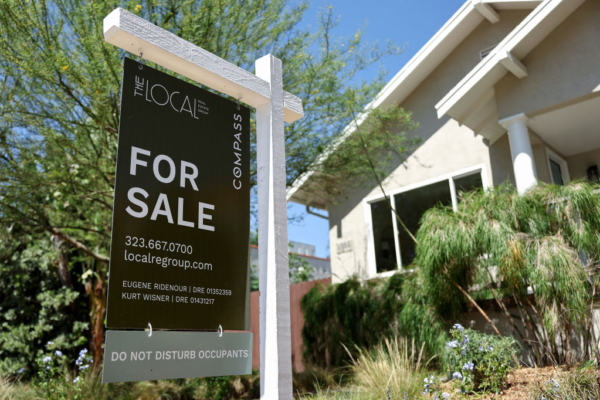In January, several large fires and persistently high mortgage rates have led to a recent phenomenon of falling housing prices in Los Angeles and throughout California.
Mr. Quan, a resident of Arcadia close to the site of the Eaton fire, noted that during this period, he observed a slight drop in housing prices while rents were on the rise. He attributed the price decline mainly to the current high mortgage rates approaching 7%, rather than the result of wildfires, stating, “The rate is too high, and many people can’t afford the mortgage.” His house is only about 4 miles away from the fire incident.
Mr. Quan also found that the fires caused his home insurance premiums to surge by 20%. Due to his long-standing contract with the same insurance company for over twenty years, this increase is relatively lower in the area, with some homeowners experiencing a 40% rise in premiums.
The House Price Index (HPI) report released recently by First American Data & Analytics revealed that in January, the HPI for the Los Angeles-Long Beach-Glendale metropolitan area dropped by 1.3% compared to December of last year and 1.9% compared to January of last year (showing increases of 0.1% and 3.3% respectively on a nationwide scale). Further breakdown by market segments indicated a 1.5% decline in first-time home buyer HPI, a 0.8% increase in mid-tier properties, and a 1.1% decrease in luxury homes.
Wildfires have had a severe impact on property prices in six cities in Southern California. According to a report by the California Association of Realtors (C.A.R.), cities like Altadena, La Cañada Flintridge, Malibu, Pasadena, Sierra Madre, and Topanga witnessed a sharp decline in home sales volume, with transactions dropping nearly 70% in the last two weeks of January compared to the previous two weeks.
Not only has the Los Angeles real estate market shown signs of price decline, but the entire California real estate market is cooling down according to the C.A.R. report. Pending home sales in January, a measure of signed contracts awaiting closing, dropped for the second consecutive month by 6.4% compared to the same period last year. The sales volume also hit the lowest level in thirteen months, with double-digit monthly decreases marking a thirty-month high record.
The median property price across California has also seen a decrease, dropping from $861,000 in December last year to $838,800 in January, a decline of 2.6%. However, it still represented a 6.3% increase compared to the adjusted figure from January last year of $789,400.
Simultaneously, the number of homes listed for sale in California has been rapidly increasing. The median number of days single-family homes stayed on the market in January was 35 days, up from 32 days during the same period last year. The sales-to-list price ratio stood at 98.6%, slightly lower than the 98.9% recorded in the corresponding period last year. The statewide Unsold Inventory Index (UII) for January stood at 4.1 months, significantly higher than December last year’s 2.7 months, indicating a robust increase in listed properties on the market.
Jordan Levine, Chief Economist at C.A.R., pointed out that after the first annual decline in December, the statewide listing inventory rebounded in January with the fastest year-over-year growth in almost four years, reaching a new high since early 2020. He believes many homeowners are realizing that a return to the market with 3% mortgage rates may not happen soon and are deciding to sell their homes.
Industry insiders in the Los Angeles real estate market stated that the fires in January had a significant impact on local housing prices in various ways.
Real estate agent Andy Huang mentioned that post-fires, some homes near the affected areas, while still intact, had to be sold at reduced prices if listed on the market. He highlighted that home insurance was a crucial factor affecting housing prices in high-risk areas, stating, “Many insurance companies are not willing to insure high-risk areas anymore, and those that do, raise premiums significantly. The policy of many insurance companies is that they will only renew policies for existing clients; they no longer take new clients.”
Construction in the Los Angeles area has long been constrained by various regulations related to building and environmental protection, leading to delays in initiating new construction projects. The difficulty in starting new construction projects is another factor influencing housing prices. Zhang Tianning, a registered insurance broker, architect, and general contractor in California, mentioned in a recent seminar that obtaining a building permit often takes more than three years before a fire incident occurs.
Moreover, the persistently high mortgage rates have reduced the purchasing power of potential buyers. According to the “Daily Mortgage Rates” website, as of Thursday, the 20th of this month, the 30-year fixed mortgage rate remained as high as 6.6%.
In Altadena, one of the areas most affected by the Eaton fire, Andy Huang noticed that despite thousands of homes being destroyed, there is now a surge in inquiries about properties. “After a crisis comes an opportunity,” he said. “The future housing market will depend on interest rates and economic conditions. With interest rates still on the high side, many people are still waiting and observing.”
What changes will the California real estate market witness in the coming months? According to the C.A.R. report, housing prices are expected to further decrease in February but are estimated to begin rising in March with the advent of the spring homebuying season.
Additionally, according to the online real estate transaction platform Zillow’s prediction, housing prices in Los Angeles County and Orange County are expected to remain relatively stable over the next year, with a projected year-over-year decrease of 0.2% by January next year.

